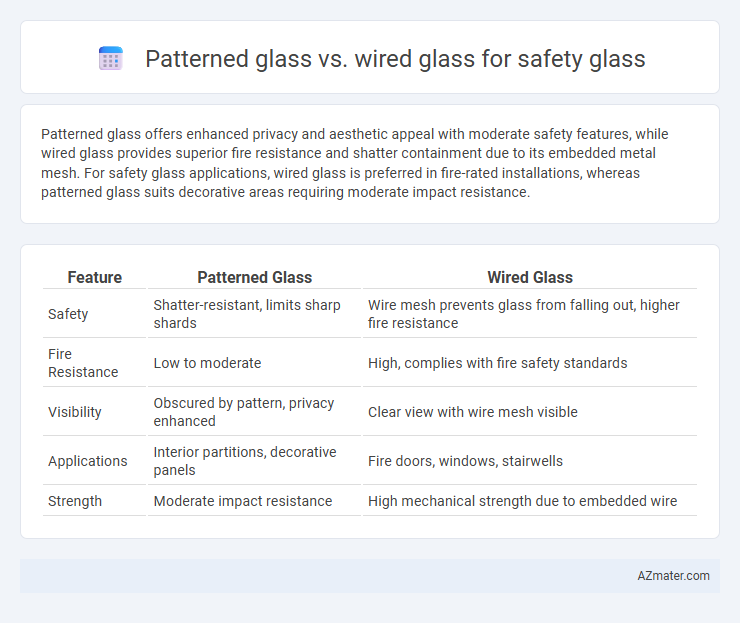Patterned glass offers enhanced privacy and aesthetic appeal with moderate safety features, while wired glass provides superior fire resistance and shatter containment due to its embedded metal mesh. For safety glass applications, wired glass is preferred in fire-rated installations, whereas patterned glass suits decorative areas requiring moderate impact resistance.
Table of Comparison
| Feature | Patterned Glass | Wired Glass |
|---|---|---|
| Safety | Shatter-resistant, limits sharp shards | Wire mesh prevents glass from falling out, higher fire resistance |
| Fire Resistance | Low to moderate | High, complies with fire safety standards |
| Visibility | Obscured by pattern, privacy enhanced | Clear view with wire mesh visible |
| Applications | Interior partitions, decorative panels | Fire doors, windows, stairwells |
| Strength | Moderate impact resistance | High mechanical strength due to embedded wire |
Introduction to Safety Glass
Patterned glass and wired glass are common types of safety glass designed to enhance security and prevent injury. Patterned glass features textured surfaces that provide privacy and diffuse light while maintaining strength, making it ideal for doors and partitions. Wired glass incorporates a metal mesh within the glass to hold fragments together upon impact, offering fire resistance and enhanced shatter protection in industrial and institutional settings.
What is Patterned Glass?
Patterned glass is a type of safety glass featuring textured surfaces that distort visibility while allowing light transmission, enhancing privacy without compromising illumination. Unlike wired glass, which incorporates embedded metal mesh to prevent shattering, patterned glass relies on its surface design to increase safety by obscuring sight lines and reducing glare. Commonly used in interior partitions, bathrooms, and decorative applications, patterned glass balances functional safety with aesthetic appeal.
What is Wired Glass?
Wired glass is safety glass embedded with a metal wire mesh that enhances its structural integrity and fire resistance by holding the glass fragments together upon impact or breakage. Patterned glass, on the other hand, features textured surfaces to obscure visibility while providing moderate safety benefits but lacks the reinforced support of wired glass. Wired glass is commonly used in fire-rated doors, windows, and partitions where fire containment and increased durability are critical.
Key Differences Between Patterned and Wired Glass
Patterned glass features textured designs that provide privacy and diffusion of light, making it ideal for decorative applications and areas requiring discretion. Wired glass incorporates a mesh of metal wires embedded within, enhancing fire resistance and preventing glass shattering during impact, which is critical for safety in hazardous environments. While patterned glass primarily offers aesthetic and light control benefits, wired glass excels in structural safety and fire protection, making each suitable for distinct safety glass requirements.
Safety Features of Patterned Glass
Patterned glass enhances safety by providing textured surfaces that reduce glare and increase privacy while maintaining impact resistance. Its unique surface design helps to prevent the spread of shattered glass during breakage, minimizing injury risk. Patterned glass also offers excellent slip resistance, making it ideal for safety applications in both residential and commercial environments.
Safety Features of Wired Glass
Wired glass incorporates a metal mesh embedded within the glass, providing superior resistance against shattering compared to patterned glass, which primarily offers privacy but limited impact protection. The embedded wire mesh helps maintain the structural integrity during impact or fire exposure, preventing large shards from falling and reducing injury risk. This makes wired glass a preferred safety glass option in fire-rated doors and windows where containment of heat and debris is critical.
Applications: Where to Use Each Type
Patterned glass is ideal for decorative applications and privacy in residential and commercial settings such as shower enclosures, office partitions, and glass doors. Wired glass is best suited for fire-rated doors, windows, and skylights where enhanced safety and fire resistance are critical, especially in industrial and institutional buildings. Choosing the appropriate type depends on balancing aesthetic needs with safety and code compliance requirements.
Aesthetic Considerations
Patterned glass offers a variety of textures and designs that enhance aesthetic appeal while diffusing light softly, making it ideal for decorative and privacy applications. Wired glass features embedded metal mesh for increased safety and fire resistance but presents a more industrial look that may not suit all interior design styles. Choosing between the two depends on balancing aesthetic goals with functional safety requirements, where patterned glass excels in customization and wired glass prioritizes durability.
Cost and Installation Factors
Patterned glass tends to be more cost-effective than wired glass due to simpler manufacturing processes and availability in standard sizes, reducing overall expenses. Installation of patterned glass is generally easier and quicker, as it does not require specialized handling or additional framing components, unlike wired glass which demands careful alignment to maintain its embedded wire mesh. Wired glass, while offering enhanced fire resistance, involves higher costs and more complex installation procedures that can increase labor time and require skilled installers.
Choosing the Right Safety Glass for Your Needs
Patterned glass offers enhanced privacy and decorative appeal while maintaining safety standards suitable for interior partitions and shower enclosures. Wired glass provides superior fire resistance and impact protection, making it ideal for fire-rated applications and areas requiring high security. Selecting the right safety glass depends on balancing aesthetic preferences, safety requirements, and building code compliance for your specific project.

Infographic: Patterned glass vs Wired glass for Safety glass
 azmater.com
azmater.com